The Corsair Hydro X Custom Water Cooling Review, on a Ryzen 9 3950X
by Gavin Bonshor on February 5, 2020 9:00 AM EST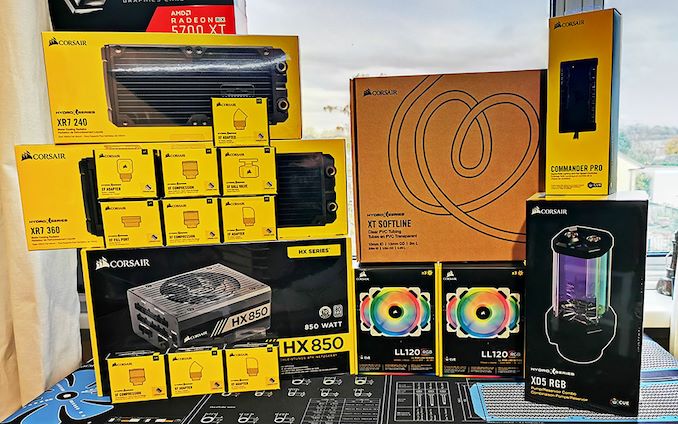
During Computex 2019, Corsair unveiled its new Hydro X series - a new range of water cooling hardware that markts its first entry into custom water cooling market. The range offers CPU blocks for multiple sockets, multiple fittings, tubing types, and a pump/reservoir combo, allowing users can build a high-performance system with nearly all Corsair branded parts. We used the Corsair Hydro X series in our ASRock X570 Aqua review and built a full system to showcase what Corsair is offering, and here is a build log of that system.
The Corsair Hydro X Series: Making a Big Splash
Widely known as one of the major players in the closed-loop cooler markets, Corsair made a big splash into the custom water cooling market with its Hydro X series last year. By offering a family of custom liquid parts that includes CPU blocks, GPU blocks, radiators, a pump and reservoir combination, to a range of coolant and fittings for users to select from to customize a full loop, Corsair is aiming to both undercut the competition but also be able to provide as much of the system as a Corsair as possible.
The Corsair Hydro X series is fully integrated to work with Corsair's iCUE RGB customization software which allows users to run Corsair RGB fans, the Hydro X series, as well as link up devices such as Corsair peripherals. Most companies that use RGB as one of its driving features are focused on creating an immersive ecosystem so that its RGB laden product families can be managed through a single interface. The Corsair Hydro X range, unlike other water cooling brands, is primarily constructed of nylon which as a material, which Corsair claims is more durable and easier to produce in higher quantities.
All of Corsair's Hydro X Series water blocks come with G1/4" threads, and each block has thermal materials pre-applied for ease of use.

Corsair Hydro X Series XC7 CPU Block for LGA115x and AM4
On CPU blocks, Corsair has two series of CPU blocks: the Hydro X Series XC7, and the Hydro X Series XC9. The Corsair Hydro X Series XC7 comes in three varieties, one for Intel's HEDT LGA2066 socket, one for AMD's HEDT sTR4 socket, and a final one designed for both Intel socket LGA115x and AMD AM4 sockets.
The Hydro X Series XC7 includes RGB LED lighting and has 60+ cold plate fins. The XC7 uses nickel-plated copper so compatibility is limited to other water cooling products that use copper and brass internally. The XC7 is available at present in black, while the XC9 comes in silver.

Corsair Hydro X Series XC9 CPU Block for LGA2011/2066 and sTR4/sTRX4
The second of two available processor blocks is the Corsair Hydro X Series XC9 CPU block. This is higher-end in terms of specifications, and is designed solely for the Intel LGA2066 and AMD sTR4 platforms. With a larger than average nickel-plated copper cooling plate designed for larger and more powerful processors, the XC9 has more cooling fins. Like the XC7, the XC9 has a transparent flow chamber for users to see water flow, but the XC9 also has a sandblasted aluminium trim designed to have a more premium look and feel. Again, RGB LEDs are present.
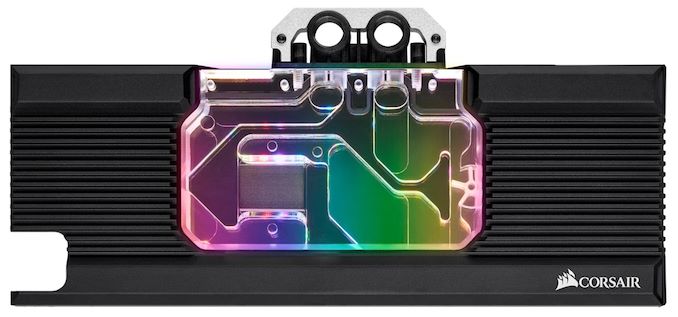
Corsair Hydro X Series XG7 RGB 2080 Ti Founders Edition GPU Block
The XG7 series represents its custom solution graphics card water blocks and although it doesn't support every available model, there is an XG7 model for reference NVIDIA GeForce RTX 2070, 2080, and 2080 Tis. Corsair also has custom variants for the ASUS ROG RTX 2080 and 2080 Ti STRIX models. For the AMD side, only one block is available and has support for reference AMD RX 5700 XT. Each block is constructed from nickel-plated copper, with a full aluminium backplate and comes with 16 integrated individually addressable RGB LEDs. For added style, the block itself has a transparent front cover to allow users to see the flow, and show off colored coolant.
At present, Corsair is offering a single pump and reservoir solution through the Hydro X Series XD5. This includes a Xylem D5 PWM pump with a 330 ml capacity reservoir. Like the majority of the range, the fluid chamber is constructed from Nylon. The the flow rate is advertised as 800 L/h at 2.1 meters of pressure. The Xylem D5 PWM pump is rated up to a maximum of 4800 RPM, and has a power draw of around 30 W. Integrated into the reservoir are ten RGB LEDs which can be controlled by the Corsair iCUE RGB software, and hook up to directly to Corsair's iCUE lighting controller.
Included with the pump are mounting brackets to allow users to mount it in various parts of a system including in drive bays and on 120/140 mm cooling fans. Also supplied is an in-loop temperature probe and a 24-pin power supply jumper so users can fill up without having to power the system components on. This is important for debugging any issues with a loop.
The Corsair Hydro X Series offers two main types of core fittings and tubing. This includes Softline in 10/13 mm ID/OD, and hardline in 14/10 mm. The Hardline is constructed from PMMA, while the Softline is made from PVC. There is a wide variety of fittings to allow users to create the right configuration including 45° and 90° angled fittings, as well as rotary splitters, ball valves, and a fill port.
The fittings themselves are constructed from brass and are G1/4" thread. Each core fitting is knurled brass and is available in both silver and black varieties. Corsair states that its range should only be used with other parts constructed from copper and brass to avoid mixing metals which can cause corrosion.
It wouldn't be a full water cooling series without radiators, and Corsair is offering its slim 30 mm XR5 radiators in six sizes including 120, 140, 240, 280, 360, and 420 mm. The thicker XR7 radiators are available in 240 mm, 360 mm and in a larger 480 mm size. Each XR7 radiator is 54 mm thick and is constructed from copper and brass, with support for 120 mm cooling fans. Dependant on the size and space inside the chassis, each radiator supports both push and pull for better cooling performance. At present, the radiators are only available in black.
The Corsair Hydro X Series XL5 coolant is manufactured by renowned fluid specialist Mayhems Solutions and is available in clear, and four colors. This includes red, green, blue and purple and each bottle is available in 1 liter capacities.


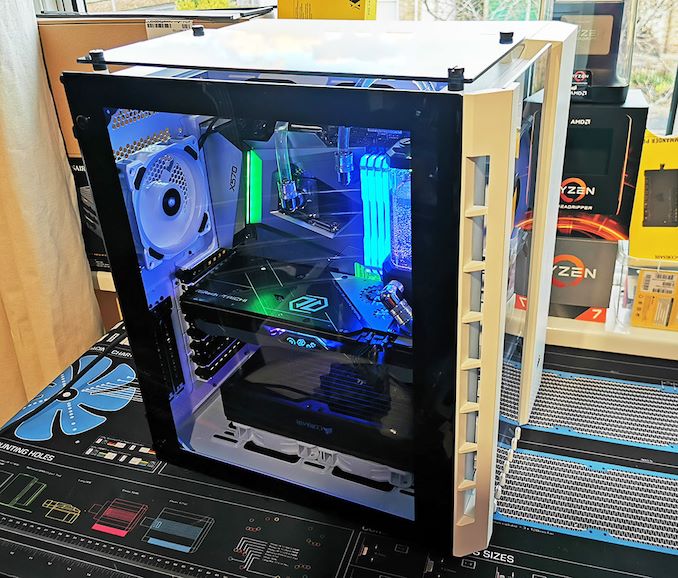
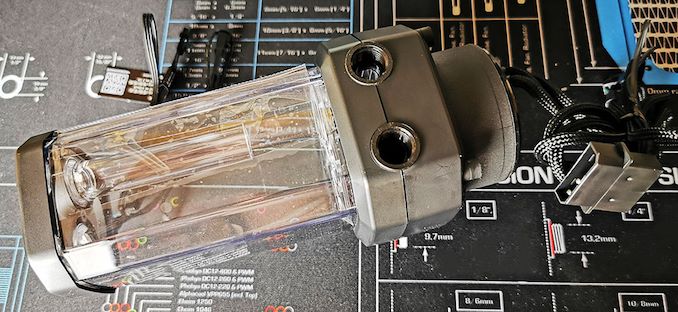
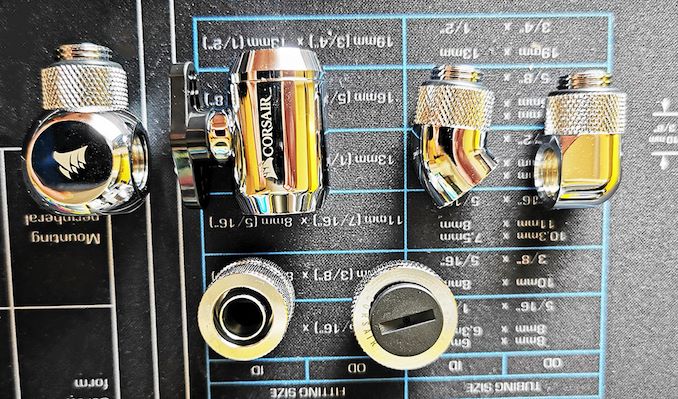
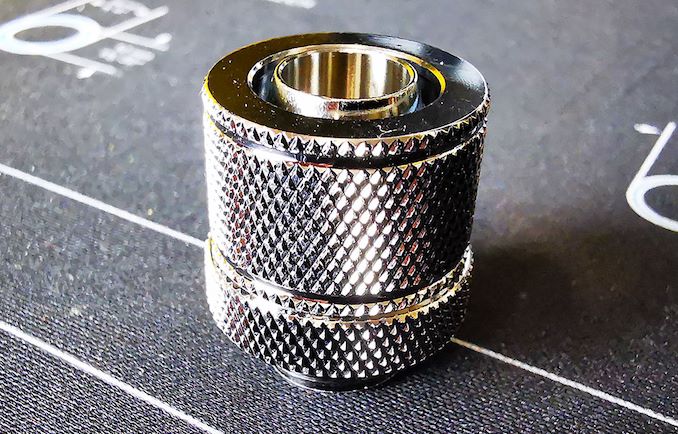
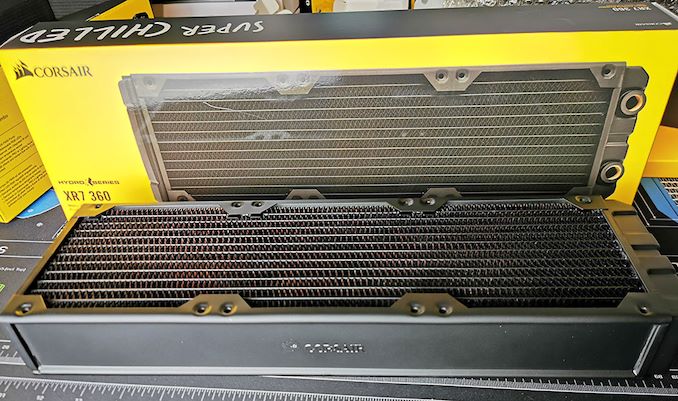









72 Comments
View All Comments
tamalero - Friday, February 7, 2020 - link
You're using the 3,000 RPM ones?Have you tried the 2000 ones?
FatBoyDiesel - Wednesday, February 5, 2020 - link
I got two EK Vardar Ferocity fans instead of Corsair's LL120 or ML120 fans for $43.98. The Corsair fans were $40-$45 each with roughly half (or less) the static pressure. The choice was obvious to me.FatBoyDiesel - Wednesday, February 5, 2020 - link
I meant Furious, not Ferocity. Autocorrect fail.DanNeely - Wednesday, February 5, 2020 - link
I paid $18 each for the 6 Phanteks 140mm x 25mm PH-F140XP-BK fans in my current build 5 years ago. Compared to the $10 each I'd previously paid for a batch of 120mm Yate Loon fans, even that felt steep. $40+ per fan is insane; thankfully unlike most performance parts fans are also used in large numbers by 'boring' system builders so getting models without paying a surcharge for frag harder disco blights should still be possible when I build my next system.From an increase in overall noise I think one of the fans started to go bad a few months ago (and from a reduction in the amount of dust on the corresponding filter I think I know which one); the other 5 are still going strong. The increase in fan noise hasn't gotten high enough for me to confirm my suspicions by selectively disconnecting fans to see if the noise goes down.
12345 - Wednesday, February 5, 2020 - link
These radiators don't require that much static pressure. They're only 16fpi and the fins aren't louvered.eek2121 - Wednesday, February 5, 2020 - link
Corsair charges a lot for their fans, however, they also have some of the best performing fans on the market.sarafino - Thursday, February 6, 2020 - link
Noctua fans easily outperform Corsair's fan lineup.Daveteauk - Sunday, February 9, 2020 - link
You're obviously a Corsair fanboy as that is completely untrue!satai - Wednesday, February 5, 2020 - link
I would like to see a comparison (both performance and noise) to a high end air cooler.brontes - Wednesday, February 5, 2020 - link
Odd that the pics show 240+360 rads and he only uses the 240. General rule of thumb is 240/280 per cooled component.As for noise, I'm running 360x2 "thin" rads (28mm?, hwl gts, corsair's oem) and good fans (a12s, notably not corsair.) Full/artificial load on an oc 3950x and a 1080ti is somewhere between actual silence and a very subtle woosh, depending on how far below spec/stock the component temps are kept. So as far as noise goes, if that's your concern and what you build around, you can safely assume it will be imperceptible/effectively silent 100% of the time, with heavy ocs, with a larger case and 360x3 or 420x2 rads (and expensive fans.)
Air is great for cpus, especially for relatively lower wattage 7nm amd stuff, if you don't mind minor spinup/spindown from brief temp spikes.
But there is absolutely no comparison with putting the gpu under water. You simply can't move 300W of heat quietly even with a fancy axial fan 2.5 slot hsf. I'm not sure that I could ever go back to the obnoxious noise of an air cooled gpu.
A single 280(?!) rad setup, as in this article, is relatively pointless and likely sounds about the same as system on full air. Which is a little disappointing and even a bit unfair in a corsair showcase, as they're rebadging the literal best components in hwl rads and the d5 pump.